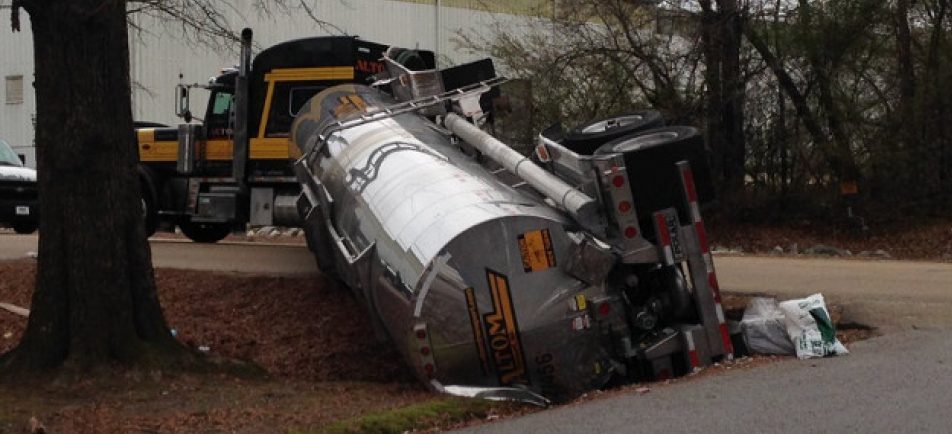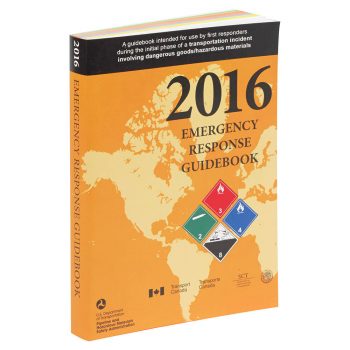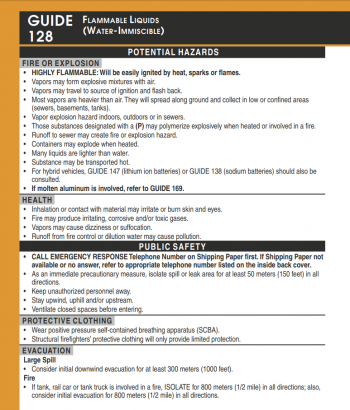
Reflecting on Hurricane Harvey’s HAZMAT Emergency: How to use the DOT Emergency Response Guide Book
posted in Alerts by Brian Gray
Reflecting on Hurricane Harvey’s HAZMAT Emergency: How to use the DOT Emergency Response Guide Book
When Hurricane Harvey hit Houston in 2017, there was a HAZMAT emergency at a chemical plant nearby that caused a lot of issues. As drivers hauling HAZMAT, are you prepared to react if you are involved in a HAZMAT spill or other dangerous situation?
The Chemical Explosion during Hurricane Harvey
The Arkema plant near Houston manufactures organic peroxides, which are used in making plastic and other materials. When the chemicals warm, they start to decompose, which creates more heat and can quickly lead to a rapid, explosive reaction. Some organic peroxides also produce flammable vapors as they decompose.
Hurricane Harvey’s heavy rains and flooding damaged backup generators and with the storage warehouse warming up, the crew transferred the chemicals to diesel-powered refrigerated trailers, but some of those stopped working as well.
When it became clear that the organic peroxide stored at the Arkema plant was going to degrade and explode the National Guard swooped in and cleared everyone in a 1.5-mile radius from the area.
First responders remained on the perimeter of the plant and when the organic peroxide did begin to explode, sending a stream of black smoke 40 feet into the air, they got sick.
“The scene was nothing less than chaos,” according to the lawsuit. “Police officers were doubled over vomiting, unable to breathe.”
As drivers, what can we learn from this HAZMAT Emergency?
If you are hauling HAZMAT and were involved in an accident or there was some sort of spill during transport, the emergency response regulations require that drivers carry information that covers at least seven different items, which include:
- Health risks of what you are hauling
- The risks of a fire
- How to deal with a small spill
- How to deal with a large spill
- First aid information
- What kind of first aid should be used
- and more
We can get this information from the SDS and you could certainly carry an SDS with you for every hazardous material you are shipping. If you have several shipments though, trying to get those SDS’s could be a challenge.
In place of the SDS you can use the little orange DOT Emergency Response Guide Book. This book has emergency response information that will cover every hazardous material shipment.
In some ways it’s a compilation of all SDS’s and it’s a very handy tool. You should have one in your truck at all times. If you are in your truck, the SDS or Emergency Response Guide Book must be maintained in the same manner as your shipping papers, meaning it must be within arm’s reach and if you leave your truck it should be placed on your driver’s seat.
How to use the DOT Emergency Response Guide Book
 The book is color coded into sections:
The book is color coded into sections:
- White section shows placards
- Yellow section shows ID numbers
- Blue section shows shipping names
- Green section shows us how far to protect down wind and in all directions
- Orange pages are the guides
If you know the ID Number of the HAZMAT being hauled
When we find, for example, that we’ve had a spill of gasoline and we know that the ID number is 1203 we can go to the yellow section and we will find ID number 1203. It will tell us to go to emergency guide 128 in the orange section. After that guide number it will say that the product is gasoline, which is the shipping name. We can now go to orange guide 128.
Each guide is going to be two pages. Guide 128 will be headed flammable liquids. Under the Potential Hazards heading we’ll see the fire risk and the health risk.
The next heading is Public Safety, under this heading you will find the Protective Clothing, and Evacuation information.
The last bold heading is the Emergency Response information, which is where you will find the response information to fires, spills or leaks, and first aid treatments.
All the information we need is right there and we can follow those instructions until a professional responder arrives at the scene, and all we had to know to use this book was the ID number.


If you know the product or shipping name of the HAZMAT being hauled
Suppose we only knew that the name of the product is gasoline? We would then go to the blue section of the guide book where it lists everything alphabetically by shipping name.
Once we find gasoline, we will see the reference to emergency guide 128 and following that is a cross reference to ID number 1203. So from the blue pages we still know to go to guide 128 and follow those instructions.
If you only knew the Placard of the HAZMAT you are hauling
If we don’t know the name or ID number, we can go to the front part of the guide book in the white section where we will find two facing pages that actually show pictures of all of the hazardous material placards and next to each group of placards will be the emergency guide.
If you see that you are hauling something with a red placard, class 3, and you see the symbol then you will find instructions for that placard to go to emergency guide 128.
What does it mean when the entry is highlighted in green?
As you flip through the yellow and blue sections of the book, you will notice that that quite often the entry is highlighted or shaded green. This means that the product is dangerous to breathe.
These entries will refer you by ID number to the green section of the book where you will find three tables.
- Table 1: Initial Isolation and Protective Action Distances
- Table 2: Water-Reactive Materials Which Produce Toxic Gases
- Table 3: Initial Isolation and Protective Action Distances for Larger Spills
These green sections will tell you how far to protect down wind and how far to protect in all directions if there’s a spill. It will also show other details, such as due to atmospheric change the toxic gas will travel further at night in the air than during the day, so a greater protective action area is needed at night.
Lastly, if you have no information on what you are hauling but know that it is green, gooey, and it smells bad, you should go to orange section guide 111. This is the very first guide in the orange section and it refers to unidentified shipments. Follow those instructions until you can get more information.
We can help you get your licenses, permits, and authorities no matter what you are hauling.
This Emergency Guide Book is a very handy tool that HAZMAT haulers should keep in their trucks as it will help protect you, emergency responders, and others that may be affected by the HAZMAT product you are hauling.
When you do your pre-trip inspection, HAZMAT haulers should be checking for the registration documents for the hazardous materials being hauled and for the Emergency Response Guide Book.
Be sure to take the time to look up different chemicals you may be hauling in this guide book. It will help you understand how to use the book and also help you prepare for any potential spills that may occur.






